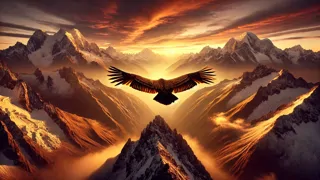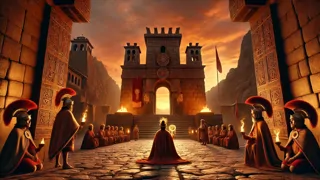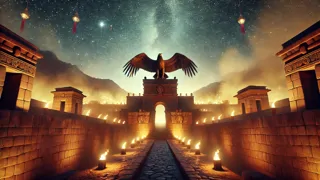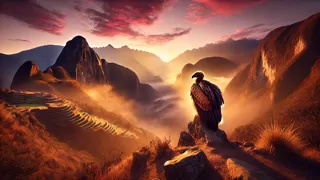Introduction
High above the emerald cloud-sea that cloaks the Cordillera Blanca, a single silhouette cleaves the dawn sky. They call this bird the Golden Condor, an omen born of Andean stars and whispering winds. For centuries, villagers in scattered adobe hamlets have spoken of its fiery plumage and the hush that falls when its great wings beat the thin mountain air. Every bone in the spine of the world trembles at its cry—a sound that echoes through deep canyons and ancient stone temples. In the time of Sapa Inca Pachacuti, when horizons shook with discord among clans, a humble seer named Yumiri knelt on a sacred ridge and caught sight of that luminous herald. She had tended the huacas of her forebears since childhood, wrapping coca leaves in prayers of peace, but never had she beheld a vision so fierce it burned the veil between earth and sky. That morning, the condor alighted atop a jagged tor, its golden feathers ablaze in the first light. Yumiri felt the pulse of prophecy tremor in her chest as the bird’s dark eyes regarded her—an unspoken message of trial, unity, and destiny that would bind her fate to the empire. From that moment, every breath she drew bore the weight of the condor’s words, and the mountain gods themselves seemed to lean closer, listening.
The Flight of Prophecy
Yumiri had never felt so small nor so alive as she did when the condor spread its vast wings against the slowly brightening sky. Every feather seemed to hum with ancient power, as though it carried the voices of long-lost shamans and the breath of mountain spirits. In the hush that followed its landing, she could hear her own heartbeat echoing in her ears, like distant drums calling a clan to war or to celebration. Deftly she rose to her feet, drawing the familiar comfort of coca leaves from the pouch at her waist. Elder tales told that only those pure of vision could decode the condor’s prophecy, and she knew her life was about to change forever.

Legends whispered that the Golden Condor was born where snow meets star, in a place so remote that even the highest peak trembled. Some said it was the messenger of Viracocha, the Creator God, who sent omens to guide the living; others claimed it carried the souls of departed rulers to the heavens. As the first shafts of sunlight pierced the mist, the condor beat its wings and rose into the swirling clouds—then circled above Yumiri, tracing a path over jagged ridges and sunlit valleys. She followed, breath quick as wind, and stepped into the condor’s trail of light, as though stepping beyond the mortal veil.
Through deserted spurs and hidden canyons she journeyed, guided by the condor’s silhouette against the sky. Rock walls carved with petroglyphs watched in silence, while fields of ichu grass bowed under her careful steps. When the bird rested on a crumbling pyramid of stone, she arrived to find the ruins alive with omens: fallen quipus tangled in the grass, wind-scored masonry that seemed almost to speak, and incense still warm from offerings left by long-gone guardians. At that moment, Yumiri understood that the prophecy must be shared with Sapa Inca Pachacuti himself, for only he could rally the scattered clans.
To reach the imperial court at Cusco, she would have to cross the perilous deserts of the coast and the sun-blasted plains of the south. Each night, the condor returned to speak its silent truth, and each day she copied its patterns into her quipu, trusting that the knots and colors held the key. When festivals swirled through sacred plazas, she paused in shadowed alleys, listening to Andean flutes and ceremonial chants, her heart heavy with the burden of what lay ahead.
Yet even as her resolve hardened, doubts gnawed at her spirit. Could mortal hands carry a message drawn from the sky? The wind seemed to answer in gusts that rattled adobe doors, and the condor’s cry soared through purple dusk like a promise. Under moonlight she whispered her fears to the stone, and in reply the condor’s silhouette passed against the heavens, a reminder that destiny often arrives on silent wings.
The Seer’s Pilgrimage
Dawn broke silver across the high plateaus when Yumiri stepped into the first village beyond the mountain’s shadow. Low adobe houses with straw-thatched roofs clustered around a central courtyard where llamas grazed on tufted grasses. Children peered from doorways, wide-eyed at her garments of dyed alpaca and the quipu knots she carried like a living scroll. She found the local curaca—chief of that valley—and spoke the condor’s message: that the empire would falter unless unity was worn like armor against encroaching strife. Skeptics murmured behind her back, for prosperity had lulled many into complacency. Yet the condor’s feather test, pressed to burning incense, glowed faint gold in her palm—an undeniable proof of heaven’s intervention.

Through the marble corridors of coastal palaces she walked next, tracking the condor’s ghostly outline in the sky. Sea breeze carried the tang of salt and fish, and ornate murals on temple walls told stories of creation—Viracocha kneeling in a primordial sea, mountains born beneath his footsteps. Every image seemed to echo the prophecy’s call to remember roots and hearth, to see beyond petty rivalries. Peasants bent under burdens of maize and quinoa offered her gifts of fresh water, while merchants in bustling bazaars whispered rumors of discontent. The empire’s web of roads lay like silver threads across the land, and she followed them with steady steps, connecting thread to thread.
When she reached the edge of the great salt desert, the condor perched atop a lone rock pinnacle, as though waiting to guide her across the shimmering expanse. Salt flats stretched beyond sight, bright and unrelenting under midday sun. Scorpions scuttled in the heat mirages, and even the wind seemed to hesitate in its passage. Yumiri knelt and offered a prayer to the mountain gods—Apu illapa and Apu Salkantay—to grant passage and safety. Her quipu glowed again, its cords vibrating like wind-struck strings. She rose at once, following the condor’s path, listening for the click of its claws on salt-crusted stone, trusting that each rhythm marked another step closer to Cusco.
By the final evening, she arrived at the city gates beneath a sky painted in molten copper. Guards in feathered head-dresses parted as she passed, quipu raised high, urging her onward. Beyond the walls, the palace of the Sapa Inca gleamed in candlelight—rows of gold and lapis lazuli shimmering among carved wooden pillars. A hush fell over the royal court as she entered, the scent of coca leaves rolling in from incense braziers. There, at the throne, sat Pachacuti—wise ruler and master builder—surrounded by advisors whose faces were drawn tight with curiosity and concern. Overhead, high on a carved lintel, a condor relief bore silent witness. Yumiri knelt and untied the first knot of her quipu.
The Unity of Sky and Empire
The court leaned forward as Yumiri’s fingers worked each knot, recounting the story woven in cord and color. She spoke of the condor’s flight over valleys scarred by feud, of omens in starlight and the hush before the sun’s rise. Each word echoed against stone columns carved with the empire’s lineage—a tapestry in which prophecy and ruler were destined to entwine. Pachacuti watched, brow furrowed, as she described the trials yet to come: drought that would test the granaries, drought that would test the faith of clans, and a gathering storm of unrest in distant provinces.

Moved by the seer’s unwavering conviction, the Sapa Inca rose and summoned his advisors. Under torchlight, they deliberated on alliances that had grown frayed, on messages that arrived by runner and faltered in translation. It was an hour of reckoning: would they choose division or embrace the condor’s call for unity? Outside, torches along the palace walls flickered like stars fallen to earth, and above them, on a high terrace, the Golden Condor roosted—silent witness to mortal choice.
At midnight, the Inca issued his decree. Envoys would ride at first light to each province, bearing gifts of maize and cloth, and word of a new covenant forged in the condor’s name. Farmers would share seed across highland and lowland alike, while artisans engraved symbols of the golden wings into doorposts for protection. A festival was proclaimed for the next full moon, when drums would echo through every valley and dancers would honor the bird of sky and prophecy.
In the following months, the empire shone with renewed purpose. Water channels were cleared, terraces erupted with new growth, and distant clans set aside old grudges to join the great road of state. Wherever Yumiri traveled, the quipu remained by her side, now complete, its last knot bound in silver thread as a sign of fulfilled promise. And when the condor soared overhead, villagers bowed in reverence and raised questions of peace. In that age, as long as the Golden Condor flew free above the Andes, the empire stood unbroken—an eternal bridge between earth and the vast sky beyond.
Conclusion
When at last Yumiri returned to the ridge where it all began, the condor circled above her, each wingbeat a silent tribute to the bonds newly forged across the realm. In the rosy light of dawn, she offered a final prayer to Viracocha and the mountain spirits, giving thanks for the prophecy that united her people beyond clan and canyon. The quipu lay heavy in her hands, every knot an echo of hope, sacrifice, and wisdom passed down through time. Below, the empire she had helped mend thrummed with life—fields ripe with maize, terraces brimming with water, and roads glistening with travelers from many nations. And though centuries would pass and the stones of Cusco would crumble, the tale of the Golden Condor lived on, carried in song, in pottery, and in the whispered prayers of mountain dwellers at dawn. Even now, travelers in the Andes pause to watch the sky, dreaming of that luminous messenger and the promise that courage, guided by wisdom, can lift an empire to new heights.



















